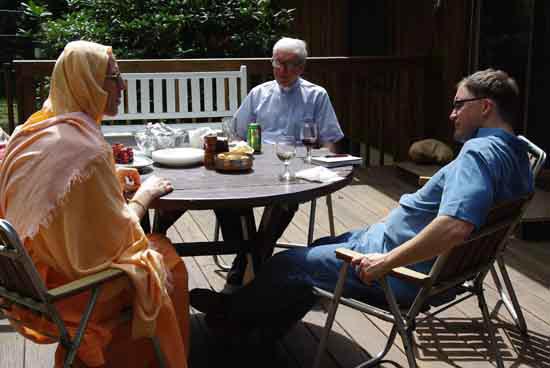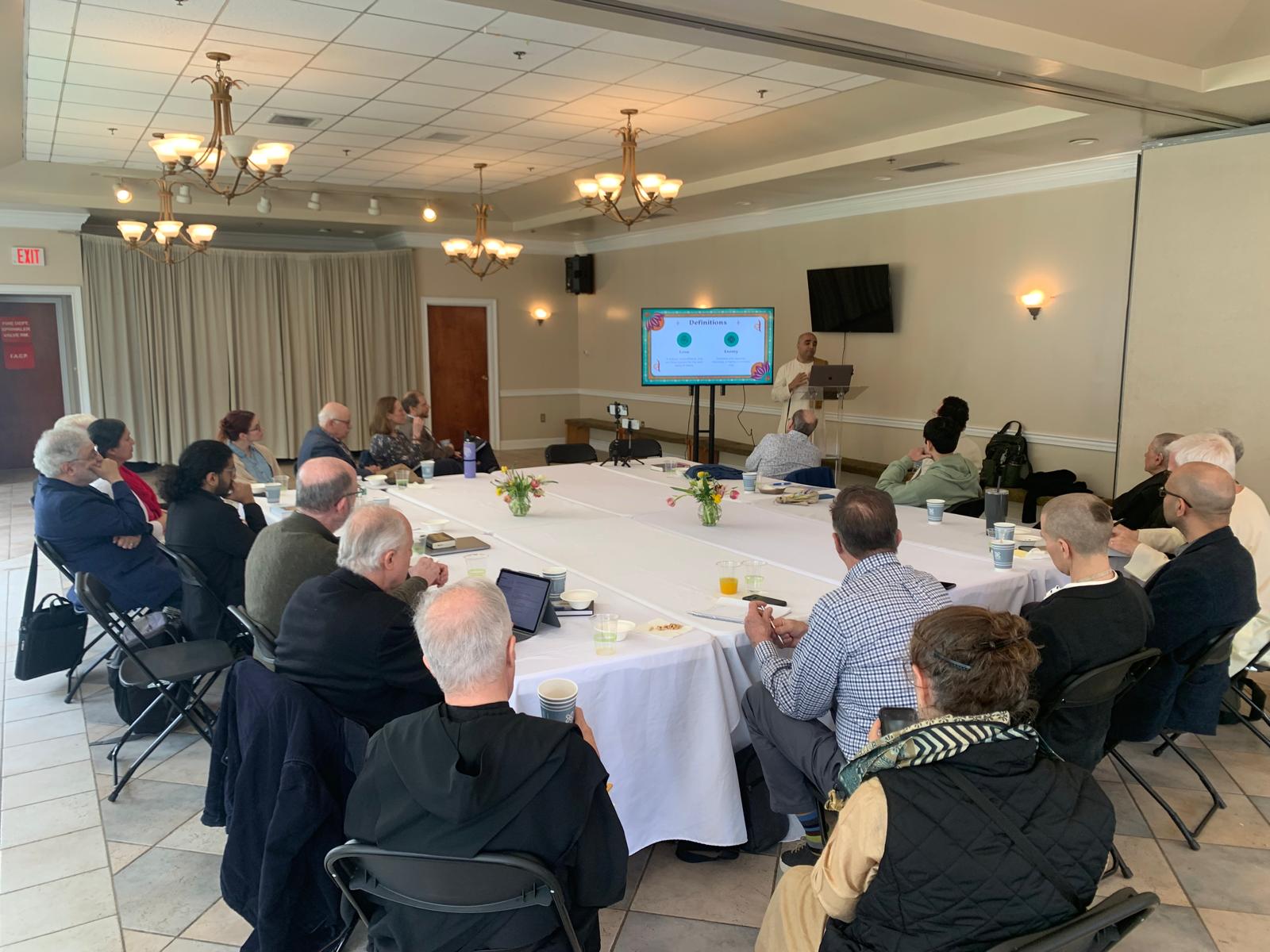Spiritual Leaders Meet for Round Table Discussion
By CHRIS WYMAN | Dec 10, 2009

If the late, world-renowned American mythologist Joseph Campbell had been sitting with the group, he would surely have been smiling as discussions of comparative religion, mythology, and the human experience helped to warm an otherwise chilly day on Wawayanda Mountain. In addition, if his associate, journalist Bill Moyers had joined him, video cameras would surely have been taping the conversations for an overdue sequel to the highly acclaimed PBS series, The Power of Myth.
Taking a break from his international lecturing series, Vaishnava swami and International Society for Krishna Consciousness (ISKCON) spiritual leader Jayadvaita Swami, or Jay Swami, came to Barry Lakes to visit an old friend and former classmate recently. Joining the small group for a simple lunch were Monsignor Robert Carroll, Pastor of Our Lady of Fatima Church in Highland Lakes, and the Rev. Robert F. Solon, Jr. Vicar of St. Thomas’ Episcopal Church in Vernon.
Let’s agree to disagree
Especially in light of the holiday season that is fast approaching, a concept that may help all people to be more tolerant of others might well be “transcendental mediation” as common, yet diverse supernatural elements help to bring about peaceful settlements, compromises and mutual understanding. This describes the general mood during the roundtable lunch and discussions that the three spiritual leaders shared with their hosts. Although their beliefs are different and in some cases extremely different, there was much common ground, shared knowledge and mutual understanding.
Conversations included the uniqueness of the Bible’s Old Testament book Ecclesiastes to discussions about “process theology.” The tenants of the latter include the idea that God interacts with the ever-changing universe and therefore God is changeable based on the actions of the universe, however, the basic elements of God, such as goodness and wisdom, remain as they are.
There was one subject on which there was disagreement: Are people in the world any better than they were 50 years ago? Monsignor Carroll referenced “original sin” and felt that people are not getting any better and that materialism is a contributing factor.
Rev. Solon’s outlook on the other hand was more Jeffersonian, feeling that people are collectively headed in the right direction, especially as it concerns progress made with human rights and equality. He also feels that the Internet is a contributing factor in transforming human society, which was created as a good thing and that there is a spark of goodness in everyone.
Jayadvaita Swami feels that mankind continues to turn away from divinity and that people have two choices: To accept that the purpose of life is to serve God’s will or to decide that the purpose of life is to satisfy one’s own needs and desires. He maintains that given a choice, the vast majority of people will choose to satisfy themselves and for that reason, over the centuries, man continues to take care of himself rather than to improve society as a whole.
About Jayadvaita Swami
Hare Krishna, Hare Krishna, Krishna Krishna, Hare Hare; Hare Rama, Hare Rama, Rama Rama, Hare Hare. Using a necklace-rosary with 108 “beats” the 16-word Hare Krishna mantra, also referred to as the Maha Mantra or Great Mantra, devotees chant the mantra 108 times, 16 times each day for a total of 1,728 times per day.
According to Jayadvaita Swami, “‘Krishna’ is a name of God (as ‘Rama’ is also), and ‘Hare’ addresses God’s divine energy. So, first, ‘Hare Krishna’ is an address to God, a prayer to God. But then, going further, ‘Hare Krishna’ can refer to the full ‘Hare Krishna’ mantra, or prayer. This is, in essence, a prayer to be engaged in God’s service.”
He continued saying, “By further extension, the movement of devotional service to Krishna becomes known as ‘the Hare Krishna movement.’ And by still further extension the adherents of the movement have become popularly known as ‘Hare Krishna people’ or simply ‘Hare Krishnas.’”
During the late 1960s when young Wall Street “stock runners” traveled up and down the streets of lower Manhattan it was not uncommon to encounter John Birchers on one side of the street and “Hare Krishnas” on the other. It was in New York City that the swami, or religious teacher, was first introduced to Krishna Consciousness.
In addition to his standard biography found under the “Biodata” tab on his Web site (www.jswami.info) or through the Wikipedia Web site, Jay Swami was born Jay Israel to a reformed Jewish family. He attended Englewood (Bergen County) schools from kindergarten at Cleveland School through his senior year at Dwight Morrow High School, basically making him a “Jersey boy” in the broadest sense. From here, his adventures became international.
As he explains his journey from high school to being one of only 49 Modern Gaudiya Vaishnavas since 1875 and teaching and lecturing in over 50 countries, he was first introduced to ISKCON in New York City in 1968. Starting with the order by stapling booklets he went on to become the editor of dozens of books and magazines. Although he attended some college classes at Carnegie Institute of Technology (now known as Carnegie Mellon University), he is in the most general sense “self-educated” and taught himself everything he needed to know in order to become a literary editor. Until he begins to travel and lecture again in the spring, he is currently residing in Mayapur, West Bengal, India.
Epilogue
After the meeting, Jay Swami shared that, “I was happy indeed that we all had the opportunity to meet together and exchange thoughts about God and spirituality.”
Rev. Solon said, “Jayadvaita quoted Krishna Scripture about what one’s purpose in life is. And it struck me that although I as a Christian can answer that question as well — and similarly as Jay did — it occurred to me the answer isn’t as clearly articulated in some ways in Christian thought. There is the Great Commandment, of course, but I’m not sure that’s the same as a purpose for life. Perhaps it is.”
Monsignor Carroll commented, “I am pleased I attended. The Swami is a spiritual person and I relate to someone who has a spiritual awareness. His question: ‘Are we as a society any better off today?’ was thought provoking.” Referring to the swami he concluded, “One of his comments, ‘you fit into your place in this life’ — in other words, if you are and do what you are gifted to do, you are satisfied, fulfilled, joyful. To live like this is a blessing.”












